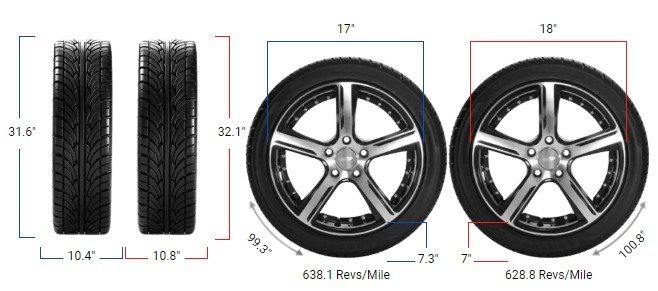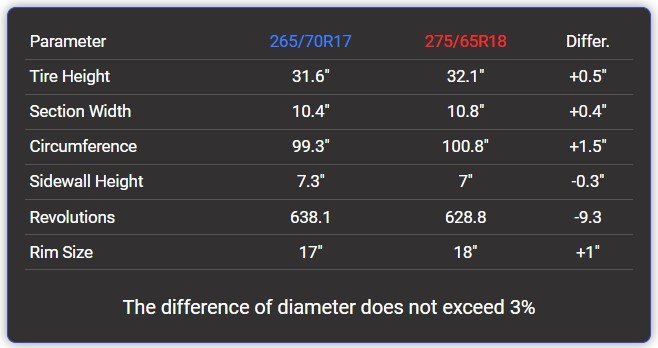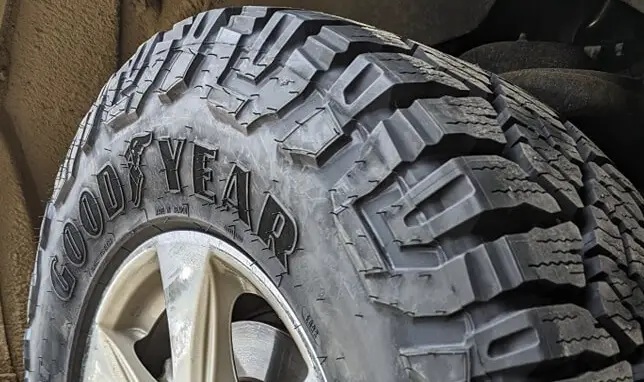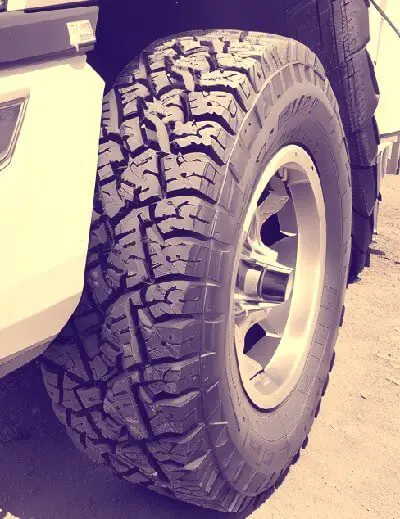Tire Size 265/70r17 vs 275/65r18
 Considering a switch from your stock 265/70R17 tires to a larger 275/65R18 size? While upsizing can enhance your vehicle’s appearance and performance, it’s crucial to understand the implications before making the swap.
Considering a switch from your stock 265/70R17 tires to a larger 275/65R18 size? While upsizing can enhance your vehicle’s appearance and performance, it’s crucial to understand the implications before making the swap.
- Wider tires may provide improved traction on loose surfaces and off-road terrains
- Speedometer will read 1.5% slower, but the difference is negligible for most drivers
- Fuel efficiency may decrease slightly due to increased rolling resistance of larger tires
- Ride comfort could improve marginally, but the change in sidewall height is relatively small
- Off-road obstacle clearance increases by about half an inch with the taller tire size
275/65r18 vs 265/70r17
Get a clearer picture of the disparities between tire size with the help of this informative comparison table.

Fitment Guide
In this case, the 1.5% difference in diameter between the 265/70R17 and 275/65R18 sizes falls within the acceptable range.
This means that switching to the larger 275/65R18 tires should not require any modifications to your vehicle’s suspension or wheel wells.
On-Road Impact
Switching to a larger tire size can have both positive and negative effects on your vehicle’s on-road performance. Let’s explore some key aspects:
- Ground Clearance: The taller 275/65R18 tires will slightly increase your vehicle’s ground clearance by about 0.24 inches (5.95 mm). This can be beneficial for navigating rough roads or mild off-road terrains.
- Ride Comfort: The larger tire size may slightly improve ride comfort by providing a larger air cushion between the road and your vehicle. However, the change in sidewall height is relatively small (-3.6%), so the difference in ride quality may not be very noticeable.
- Speedometer Accuracy: With the larger 275/65R18 tires, your speedometer will read slightly slower than your actual speed. At 20 mph (32.19 km/h), the speedometer will show 20.3 mph (32.66 km/h). This 1.5% difference is minor and unlikely to cause any significant issues.
- Fuel Efficiency: The larger tire size will cause a slight increase in rolling resistance, which may lead to a minor decrease in fuel efficiency. However, the impact on gas mileage should be minimal, given the small difference in tire size.

Off-Road Impact
If you occasionally take your vehicle off-road, the switch to 275/65R18 tires can offer some advantages:
- Traction: The wider tread of the 275/65R18 tires (10.83 inches vs. 10.43 inches) can provide better traction on loose surfaces like sand, gravel, or mud.
- Obstacle Clearance: The increased tire diameter will give you slightly more clearance when navigating over rocks, roots, or other obstacles. However, the difference is only about half an inch, so it may not be significant in most off-road situations.
- Durability: The larger tire size may offer marginally better durability and wear resistance due to the increased tire volume and weight capacity. However, factors like tire brand, tread pattern, and driving habits will have a more substantial impact on tire longevity.
What is the Main Difference Between 265/70r17 and 275/65r18?
The main difference between 265/70R17 and 275/65R18 tires is the overall diameter. The 275/65R18 tires are 0.47 inches (11.9 mm) taller, which is a 1.5% increase in diameter compared to the 265/70R17 size.

Can I Use 275/65r18 Instead of 265/70r17?
Yes, you can use 275/65R18 tires instead of 265/70R17 because the difference in overall diameter is within the acceptable range of 3%. This means the new tire size should fit your vehicle without requiring any modifications.
How Much Taller Is a 275/65r18 Tire Than a 265/70r17?
A 275/65R18 tire is 0.47 inches (11.9 mm) taller than a 265/70R17 tire. This represents a 1.5% increase in the overall diameter of the tire.
How Much Wider is a 275/65r18 Tire Than a 265/70r17?
A 275/65R18 tire is 0.39 inches (10 mm) wider than a 265/70R17 tire. The 275/65R18 has a width of 10.83 inches (275 mm), while the 265/70R17 has a width of 10.43 inches (265 mm).
Our Observations
Switching from 265/70R17 to 275/65R18 tires offers some potential benefits, such as improved ground clearance, traction, and off-road capability.
However, the differences are relatively small and may not be noticeable in everyday driving. The 1.5% difference in overall diameter is well within the acceptable range, so fitment issues are unlikely.
While the wider tires may slightly impact fuel efficiency and speedometer accuracy, these changes are minor and should not cause any significant concerns.
Ultimately, the decision to switch tire sizes will depend on your specific vehicle, driving preferences, and intended use.

Meet Caitlin McCormack, a Tire Size Expert and Blogger Passionate About Everything Related to Tires. With Years of Experience in the Tire Industry, Caitlin Has Become an Expert in Tire Sizes and Their Impact on Vehicle Performance.
